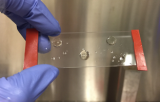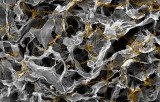
Hydrogels
Hydrogels are three-dimensional networks of hydrophilic polymers capable of absorbing large quantities of water or biological fluids. Indeed, they can sometimes contain up to 99% water in their final form. The resulting products have a high degree of flexibility comparable to living tissue, and as they are largely made up of water, they are naturally compatible with such tissue. They have been used for tissue engineering, drug delivery, gene therapy and high-throughput drug screening, among other applications.
The physicochemical properties of hydrogels, such as :
- Mechanical strength,
- Porosity,
- Their swelling behavior, can be adjusted to modulate their biological response.
- Hydrogels can be made from natural or synthetic polymers, and can be chemically or physically cross-linked to retain their structure.
- The biocompatibility of hydrogels and their ability to retain large quantities of water make them attractive for use in biological applications.
Some specific examples of hydrogels:
Include alginate hydrogels for tissue engineering and hydrogels based on chitosan, collagen or hyaluronic acid for drug delivery. They have proved useful in a range of cell culture applications, revealing fundamental phenomena regulating cell behavior and providing tools for the directed expansion and differentiation of various cell types in a way not possible with conventional culture substrates. They can also be used for 3D cell culture, which is more physiologically relevant than 2D cell culture, as it better mimics the in vivo environment. As they can be used to mimic the tissue extracellular matrix (ECM), which plays an essential role in regulating important cellular functions such as propagation, migration, proliferation and differentiation, as well as tissue morphogenesis.
Hydrogels can be used to:
- Study cellular behavior in response to various stimuli (mechanical forces, chemical gradients and electric fields),
- Encapsulate cells,
- Drug screening, disease modeling and tissue engineering,
- Study cell-matrix interactions.



